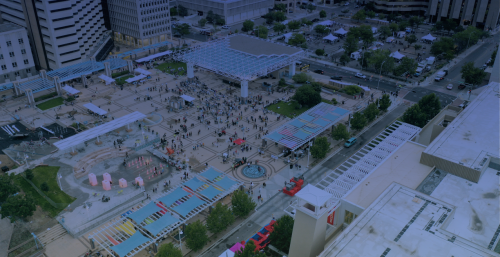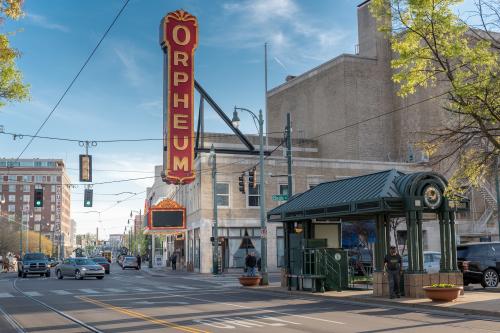Placemaking as a field is at an inflection point. Since my organization, Project for Public Spaces, started using the term “placemaking” in the 1990s to describe community-based processes for visioning and improving public spaces, we have watched it spread and evolve into many different forms. Creative placemaking, equity-based placemaking, placekeeping, and now, the more expansive transformative placemaking have challenged and stretched the definition to address new, multifaceted, or often-neglected issues facing communities. But as all fields evolve, tensions also emerge.
On the one hand, placemaking is seemingly everywhere. There have never been so many designers, planners, and place managers who describe what they do as “placemaking.” Many foundations, planning departments, economic development agencies, and others have adopted placemaking as a key strategy to foster vibrant communities.
On the other hand, in some quarters, placemaking is looked at with suspicion. Community activists and some academics ask: Is placemaking just gentrification with another name? With pressing needs like COVID-19 and climate change, city planners and other professionals ask: Is placemaking big enough? Even placemaking practitioners themselves are always asking: What’s next?
The recent Bass Center for Transformative Placemaking research series Beyond traditional measures: Examining the holistic impacts of public space investments in three cities, by Hanna Love and Cailean Kok, uses qualitative research of three public spaces in Flint, Mich., Buffalo, N.Y., and Albuquerque, N.M. to shed new light on these questions and chart a path forward for more equitable and effective placemaking. Its insights are many, but here are some of the top findings for placemaking practitioners.
1. Public spaces for ‘everyone’ don’t work for everyone
When asked who a public space is “for,” many placemaking practitioners are quick to say “everyone.” However, in saying that a public space is for everyone, placemakers can enshrine a one-size-fits-all approach that fails to reflect exclusionary dynamics occurring on the ground.
As the Bass Center’s research on social cohesion in public spaces found, for a public space to truly be inclusive, practitioners need to center the needs of often-excluded groups rather than “the public” at large. The cases of Canalside in Buffalo and Civic Plaza in Albuquerque demonstrate that this can be a challenge for downtown public spaces, which are centrally located but have barriers for people of color, low-income people, and others. These barriers can include transportation, costs (such as admission, travel, food, child care, or even time), and perceptions of historically unequal investment in the public realm—all of which prevent some residents from accessing and using a space.
The Flint Farmers’ Market offers a strong case study in how to apply a lens of equity rather than equality to investing in downtown public spaces. The Bass Center’s research found three strategies key to their success: 1) offering programming targeted toward users most likely to be excluded; 2) partnering with community-based organizations to build trust with residents; and 3) co-locating with a public transportation hub that connects neighborhoods all around Flint to the market.
In other words, rather than thinking of the public space as a celestial body whose gravity attracts everyone equally, market managers thought of the space as a single node in a complex network. Some linkages in the network are harder to forge than others, and it takes intentional acts of connection to rewire those relationships. If place managers don’t cultivate those linkages, no amount of “gravity” can overcome the gaps in the network, and true equity in access and usage is unlikely to be achieved.
2. Placemaking needs thoughtful place governance to sustain itself
Dating back to the 1980s, Project for Public Spaces has advocated for the importance of place governance for the performance of public spaces. Many of the factors that affect people’s decision to visit or stay in a public space—including cleanliness, safety, and activities—are less a matter of one-time design, and more a matter of ongoing maintenance, programming, staffing, and policy.
To make decisions about these activities, place governance typically involves collaborations among public, civic, and private sectors. Depending on stakeholders, divisions of labor, rules of engagement, and incentives, these collaborations can be more effective and equitable than if any one party had the full responsibility—or they can be just the opposite. Likewise, these collaborations can be durable—outlasting political administrations, organizational successions, funding losses, and other shocks—or they can be volatile and struggle to meet the needs of all stakeholders.
The Bass Center’s findings on place governance found that the organizational capacities, funding structures, and missions of place governance entities shape their ability to offer inclusive, community-centered programming. In Buffalo, for instance, the significant weight of state investment in Canalside necessitated programming that could attract revenue to fill budget shortfalls, rather than solely community-based events. Additionally, Brookings’s interviews revealed that some members of the public had concerns about longtime plans to develop the waterfront into a mixed-use entertainment and tourism destination—yet when one considers the place governance arrangement behind the space, it makes sense. The mission of New York’s Empire State Development subsidiary, the Erie Canal Harbor Development Corporation, is to “promote a vigorous and growing state economy,” and real estate development falls within its mandate and its skill set.
What this tension reveals is that early place governance decisions about who has power, who does what, and how it will get paid for have a significant impact on placemaking.
3. When it comes to money, ‘how’ sometimes matters more than ‘how much’
While placemaking requires some amount of funding, the communities Project for Public Spaces works with are often surprised by what they can accomplish on a budget. After co-creating a shared vision for a public space, communities can first experiment with “lighter, quicker, cheaper” ways of achieving that vision, rather than seeking big upfront investments that can become intractable mistakes. If these early experiments are successful, stakeholders can use this momentum to attract additional investment over time.
This being said, one of the most crucial—and most difficult—kinds of funding to secure is for public space maintenance, programming, and design adjustments. The place governance entities that steward the three public spaces Brookings studied had more or less found means of sustaining themselves financially—however, the mechanisms of funding had an impact on public perceptions. In the case of Albuquerque’s Civic Plaza, an initial grant energized a cross-sectoral group to improve the public space, but without ongoing flexible funding, they adopted a more corporate management structure that hindered efforts to foster an inclusive and locally empowering space.
The Flint Farmers’ Market, on the other hand, has a mix of foundation, private sector, and self-generating revenue sources that have allowed it to achieve recognition as an equitable and vibrant public space. While vendors alone do not provide enough revenue to cover operating costs, renting space to diverse vendors that sell healthy and affordable food generates some revenue while also meeting the market’s mission. Meanwhile, significant ongoing philanthropic support from the Mott Foundation has helped ensure that this space remains permanently affordable and can offer community-centered programming that connects low-income residents to fresh food.
In short, developing revenue streams that are aligned with the mission of a public space is crucial to its long-term success.
4. The future of public space research is qualitative
Public spaces are complex places. They bring together a staggering array of people, activities, and systems and produce diffuse and unpredictable benefits and costs.
That’s why strictly quantitative research on public spaces simply doesn’t cut it anymore. In the 1960s and 1970s, researchers such as William H. Whyte and Jan Gehl invented groundbreaking observational techniques to track the number and kinds of people in a space and how they use it. While these tools offered a baseline to understand the design factors that make the difference between a well-used public space and poorly used one, they only scratched the surface. Issues such as public perception, interpersonal interactions, and broader benefits to public health, the economy, and the environment remained opaque.
Since then, academic research on public spaces has continued to evolve, with a growing emphasis on qualitative techniques. For one, the City University of New York’s Setha Low has made a career of testing new ethnographic approaches to researching and improving public spaces. Yet these approaches still remain the exception rather than the rule for practitioners, partly due to a lack of expertise and partly due to their additional expense.
As the Brookings series demonstrates, qualitative techniques can reveal the complex web of relationships that underpin public spaces. This is perhaps most clear when looking at the series’ findings on the economic impacts of public spaces. Traditional economic measures tend to focus on outcomes such as property values, vacancy rates, and revenue generation, mostly because these are the easiest outcomes to measure. But they may not be the most significant outcomes, and increasing property values may not even be a desirable outcome in gentrifying neighborhoods. On the other hand, systematically interviewing and analyzing stakeholder insights better reveals the chains of causality that lead to broader outcomes, such as changing public perceptions and behaviors, influencing decisions about further public and private investment, and supporting emerging businesses.
The work to improve public spaces is never finished
While there’s a great deal to learn from these three case studies, it’s also important to remember that they are only snapshots of a particular moment in the evolution of these public spaces.
Time is perhaps the most crucial dimension of placemaking. A public space may not meet its full potential today, but no place is a lost cause. The true test of a public space is whether or not its economic, social, civic, and physical outcomes improve over time. When they do, it’s almost always the result of effective place governance—the stewardship of a public space and the broader policies, programs, and funding that support it. Behind every successful public space is a small group of people with a great capacity to watch, listen, repair, tinker, and care.
The Brookings Institution is committed to quality, independence, and impact.
We are supported by a diverse array of funders. In line with our values and policies, each Brookings publication represents the sole views of its author(s).






Commentary
Four takeaways on public space investment for placemakers
August 20, 2021